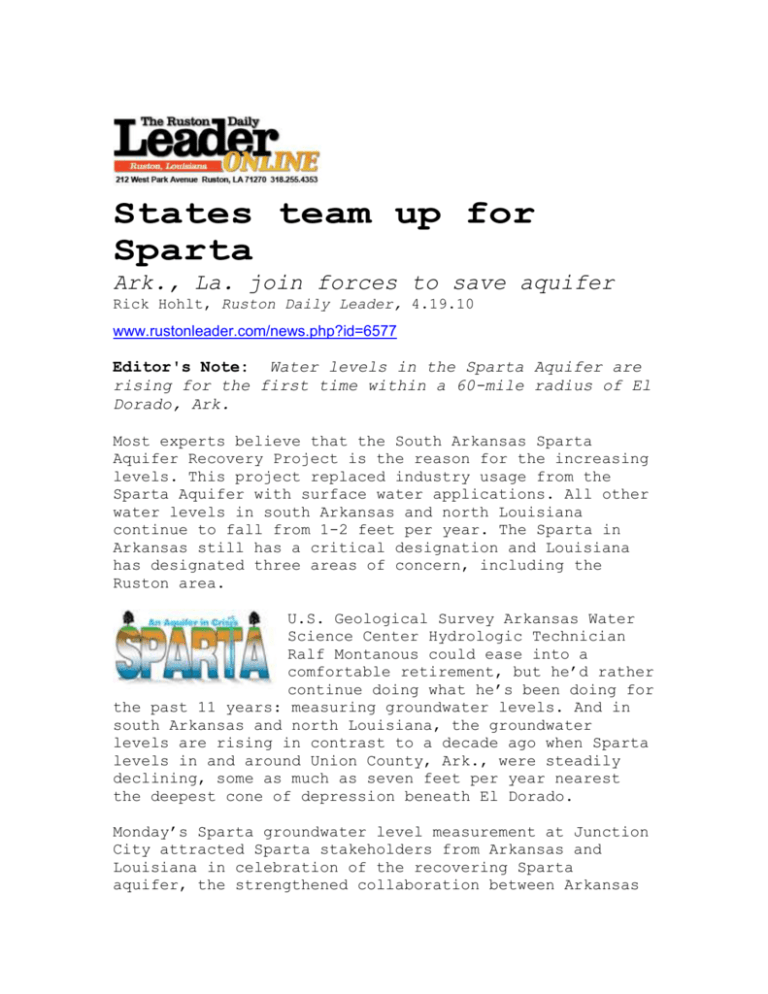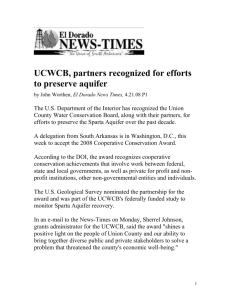Ruston Daily Lead 4/19/10 - GIS Applications Laboratory
advertisement

States team up for Sparta Ark., La. join forces to save aquifer Rick Hohlt, Ruston Daily Leader, 4.19.10 www.rustonleader.com/news.php?id=6577 Editor's Note: Water levels in the Sparta Aquifer are rising for the first time within a 60-mile radius of El Dorado, Ark. Most experts believe that the South Arkansas Sparta Aquifer Recovery Project is the reason for the increasing levels. This project replaced industry usage from the Sparta Aquifer with surface water applications. All other water levels in south Arkansas and north Louisiana continue to fall from 1-2 feet per year. The Sparta in Arkansas still has a critical designation and Louisiana has designated three areas of concern, including the Ruston area. U.S. Geological Survey Arkansas Water Science Center Hydrologic Technician Ralf Montanous could ease into a comfortable retirement, but he’d rather continue doing what he’s been doing for the past 11 years: measuring groundwater levels. And in south Arkansas and north Louisiana, the groundwater levels are rising in contrast to a decade ago when Sparta levels in and around Union County, Ark., were steadily declining, some as much as seven feet per year nearest the deepest cone of depression beneath El Dorado. Monday’s Sparta groundwater level measurement at Junction City attracted Sparta stakeholders from Arkansas and Louisiana in celebration of the recovering Sparta aquifer, the strengthened collaboration between Arkansas and Louisiana and federal and state funding that will allow the Union County Water Conservation Board to continue monitoring the Sparta’s recovery through late 2011. Each April, Montanous records the official annual groundwater level in eight solar powered monitoring wells in the five South Arkansas county, three North Louisiana parish Sparta aquifer recovery monitoring network. As bistate Sparta stakeholders looked on, Montanous explained the process and demonstrated equipment as he measured the groundwater level at the Junction City Sparta recovery monitoring well. When the first official Sparta recovery groundwater level measurement was recorded in October 2006, the Junction City well had risen five feet and seven inches since October 2004, following the first of three major Union County industries’ conversion from Sparta groundwater to the alternative and abundant surface source: Ouachita River clarified industrial water provided by the board. By late 2005, all three industries — El Dorado Chemical, Great Lakes/Chemtura Central Plant and Lion Oil Refinery — had converted to Ouachita River water, and by April 2009, the Junction City well had risen 18.3 feet. Dave Freiwald, USGS Water Science Center assistant director, said “We have seen well levels nearest the deepest cone of depression beneath El Dorado rise as much as 59.3 feet as of April 2009. In the Spencer, La., monitoring well, over 56 miles from El Dorado, water levels have risen five feet.” Prior to Union County’s efforts, all wells in the fivecounty, three-parish South Arkansas, North Louisiana monitoring area were steadily declining, some as much as seven feet per year. While most areas of the world are monitoring groundwater decline and figuring out how to address the problem, south Arkansas and north Louisiana are monitoring aquifer recovery, none of which would be possible without the abundant supply of surface water in the Ouachita River. According to Union County Water Conservation Board President Robert Reynolds, “When the board reports rising Sparta groundwater levels to the public, what we are reporting are these official annual April measurements, which USGS first records and validates in a scientific process.” Earlier this year in a ceremony at the El Dorado Chamber of Commerce, Congressman Mike Ross announced a $300,000 Interior Department appropriation through USGS Arkansas Water Science Center for continued monitoring of Sparta aquifer recovery in south Arkansas and north Louisiana. In addition to the federal funding, the board has also received state funding from both Arkansas and Louisiana to support Sparta recovery monitoring through fall 2011. According to Louisiana Sparta Groundwater Commissioner Rick Hohlt, “We have been working toward substantive bistate Sparta Aquifer conservation to ensure adequate drinking and industrial water for current and future generations.” “(Monday’s) gathering represents a much larger network of Sparta stakeholders committed to our shared mission on behalf of the Sparta aquifer, which knows no geographic boundaries: The guiding purpose and primary objective of the Union County Water Conservation Board and Louisiana Sparta Groundwater Commission is to conserve, protect and maintain the Sparta Formation Aquifer as a continuing source of high quality, potable water for current and future consumers by providing for affordable, alternate sources of fresh water pursuant to the authority and responsibility granted by the states of Arkansas and Louisiana.” Monday’s Sparta groundwater level measurement at Junction City drew Sparta stakeholders from Arkansas and Louisiana in celebration of the recovering Sparta. Kneeling (from left to right): Ben McGee, supervisory hydrologist, USGS Louisiana Water Science Center; Sherrel Johnson, Union County Water Conservation Board grants administrator; Ralf Montanus, hydrologic technician, USGS Arkansas Water Science Center; (standing front row, left to right) Lindsay Gouedy, education coordinator, Louisiana Sparta Ground Water Commission; Patricia Herring, office manager; 4th District (Arkansas) Congressman Mike Ross; Alice Stewart, Louisiana Sparta Ground Water Commission; Mickey Mays, Louisiana Sparta Ground Water Commission; Ginger Risinger, hydrology technician, Union County Conservation District; (standing back row, left to right) Robert Reynolds, president, Union County Water Conservation Board; Arkansas State Representative John Lowery; Dave Knoebel; Michelle Fisher, hydrology tech assistant, Union County Conservation District; and Cindy Woolsey, administrative assistant, Union County Water Conservation Board. Also in attendance, but not pictured, was Louisiana Sparta Groundwater Commissioner Rick Hohlt.








